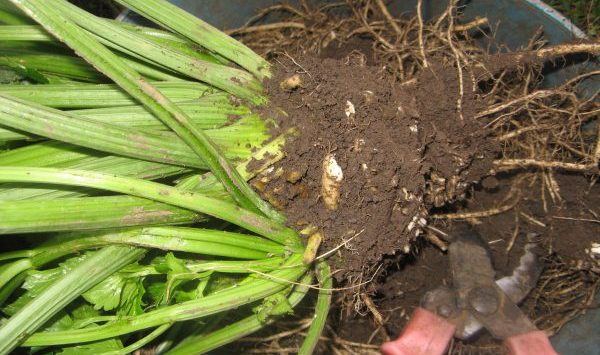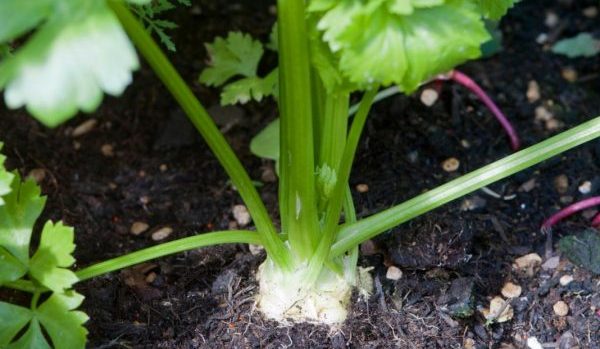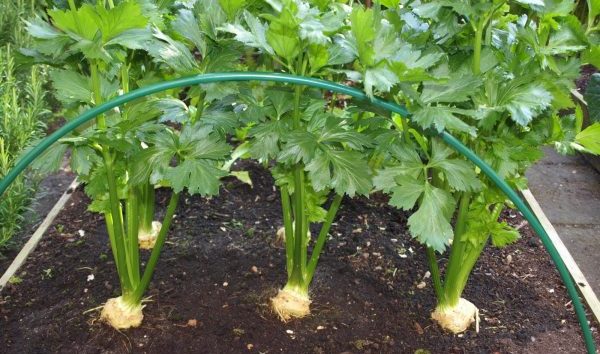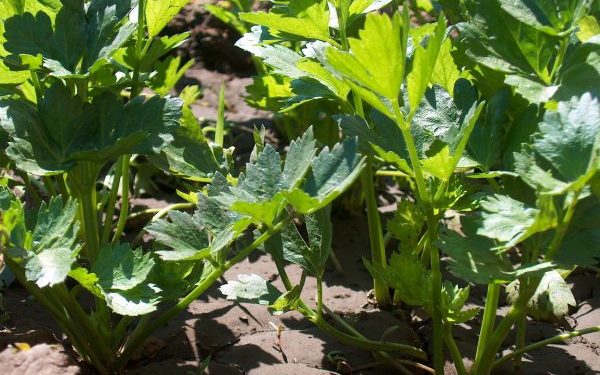Celery: cultivation and description of varieties
Content
Views
Such types of celery are known: leaf, root, petiolate. This does not mean at all that only the roots are eaten in the root, and only the leaves in the leaf. All parts of the cultivated plant are edible, it is even difficult to believe that it was bred by selection from a very common wild fellow, which has a thin fibrous root.
Leaf celery is cultivated if they want to eat green leaves that are fragrant and rich in vitamins. All varieties of leaf celery form a rosette early, leaves on hollow cuttings can be cut off throughout the season, but coarse, highly branched roots do not eat. This species can be grown at home.
Petiole varieties are distinguished by large, fleshy petioles, long, erect, with a thick base and tender pulp. They are eaten fresh, and various dishes are prepared from them. The root crop remains underdeveloped, usually not eaten.
This wonderful plant can be found more often in the supermarket than in summer cottages. The only exception is root celery; summer residents have taken up its cultivation in recent years. When cultivating varieties of root celery, the greens will have to wait a long time, in addition, in order for a large root crop to mature, only the side leaves in a very limited amount need to be cut off.
Everything is eaten with him - from the root to the seeds. But the root crop is formed for a very long time - from 120 to 170 days. It is eaten raw, boiled, fried, added when preparing the first and second courses. The seeds contain a lot of essential oils, they are most often used as a seasoning or for making sauces, marinades.
Celery planting video
Informational video with useful tips for gardeners.
Growing petiole
The cultivation of stalked celery has not become widespread, which is probably why there are not so many varieties. The most famous varieties of celery stem:
- early ripe "Malachite" with dark green leaves and a growing season of 80 days;
- self-bleaching variety "Golden" ripens for about 150 days, its fleshy petioles are not hollow inside;
- "Pascal" ripens for about 100 days, and the stems grow up to 22 cm;
- mid-late "Triumph" ripens up to 130 days, its emerald-green stems grow up to 30 cm, and it can be cultivated not only in the open field, but even at home;
- "Tango" with a growing season of 180 days gives bluish-green stems without fibers, they are slightly curved on the inside, and have a rich taste.
Growing stalked celery in the middle lane begins with sowing seeds at home. Seeds are sown at home in early March, and in early May, the seedlings are transferred to open ground. The site must be chosen open, lighted, with fertile soil. Plants are planted in specially prepared trenches, leaving at least 20 cm between them. Delicate plants, only taken out of the house, it is advisable to cover for a time when frosts are still possible.
2 weeks after planting, the plants are fed, for this they take mullein, chicken droppings or urea, dilute 0.5 liters of fertilizer with a bucket of water. Fertilize carefully, as an excess of nitrogen can lead to cracking of the stems.
When the stems grow to 25 cm, the bleaching process begins. Weak shoots are removed, the rest of the petioles are wrapped in paper so that only the leaves remain open. Hilling serves the same purpose - bleaching, so before harvesting, grown plants are hilled twice. This is a feature of caring for him.
Celery needs abundant watering, especially on light soil, it will grow with a lack of moisture, but the inside of the stems will become inedible. Too dry soil will lead to early shooting. But wet ground tends to attract slugs and snails. So that they do not encroach on the juicy stems, you need to weed, do not leave plant debris between the rows.
The crop is harvested in the fall, when September is drawing to a close. For this, the plants are dug up along with the roots. Growing stalked celery in the country requires attention, but care is not very difficult, and the vitamin crop is so tasty and healthy that it is worth it.
Growing root
Root celery is cultivated much more widely than other species, there are many varieties. The most famous of them:
- "Prague giant" - large roots with light pulp ripen in 120 days after the emergence of sprouts, they are distinguished by a bright taste and smell;
- "Diamant" ripens in 150 days, its smooth round roots have an average weight of 200 g, light pulp does not change color even after heat treatment;
- "Cascade" - also ripens 150 days after germination, rounded roots with light pulp have lateral roots only at the bottom;
- "Apple" - the ripening of the root crop lasts from 90 to 160 days, the snow-white pulp is rich in sugars (which affects its taste), the weight can be from 80 to 140 g, so on 1 square meter it can grow up to 5 kg, this variety is practically not susceptible diseases;
- "Root Gribovsky" gains its weight (65 - 135 g) in 120 - 150 days after the emergence of sprouts, its pulp is light with yellow;
- "Albin" matures in 120 days, most of the rounded root crops with a diameter of about 12 cm rise above the ground when grown, the roots grow only in the lower part, the very top of the white root crop has a greenish tint;
- "Strongman" gains its average weight (400 g) in 170 days after the sprouts have appeared from the seeds, its roots are large, rounded, white with yellowness, the pulp is sweet and aromatic, lateral roots grow only from below;
- "Egor" is valued for its high sugar content in large rounded root crops with yellow-gray skin and white flesh, which ripen in 180 days;
- "Gigant" produces very large roots - up to 700 g with dense white pulp and beige skin, its leaves are large dark green, and the roots grow only at the bottom;
- "Anita" - oval or round root crops weighing up to 400 g with beige skin and white flesh ripen in 160 days, the variety is known for its delicious root crops and high yields;
- “Maxim” is the latest variety that is cultivated in our country, it ripens in 200 days, roots with creamy pulp have a piquant taste and grow up to 500 g, which experts recommend for long-term storage.
Only in the south is it possible to grow root celery by sowing directly into the ground, most often the seeds are sown in small dishes at home, and when strong seedlings grow, they are planted in a garden bed with prepared soil. Light sandy loam soil, nutritious, is suitable for celery. Before planting it, you cannot fertilize the soil with manure, it is good if the manure was introduced for previous crops, otherwise the root crop will grow crooked.
After sowing up to 6 leaves, the seedlings are grown at home, then planted in moist soil at a distance of 30 cm. Planting is done carefully - so as not to damage the delicate roots, not to deepen the growth point.Seeds lose their germination over time, so you only need to take fresh seeds for sowing. To speed up the germination time of seeds, they are soaked in warm water for 2 days.
At the end of summer, excess soil is turned away from the root crop, it is necessary that the head protrude from the ground. At the same time, the side roots are cut off with a sharp knife. Harvested before frost, usually not earlier than mid-October.
Growing leaf
Cultivation of leaf celery is not very common among summer residents, although it does not require maintenance for 24 hours. Celery grows in a greenhouse, in a garden bed, even at home. The most famous varieties:
- "Kartuli" is an early Georgian variety, its greens can be cut as early as 65 days after germination, it shows resistance to drought;
- "Vigor" ripens in 70 days, is not afraid of either drought or cold weather, does not require special care, gives carved fragrant leaves;
- "Zakhar" gives a very high yield, but technical maturity occurs only 150 days after germination, although after 105 days its leaves can be eaten;
- "Delicate" is a mid-ripening variety that ripens in 100 days, its rosette is semi-vertical, greens are dark green with a strong aroma;
- "Samurai" - gives greens in 75 days after the seeds have sprouted, the rosette grows up to 65 cm, fragrant curly greens do not need special care, but are very much appreciated by culinary experts.
Growing leaf celery is possible everywhere, everyone can take care of it. Seeds can be sown directly on the garden bed, but such sowing gives uneven shoots, usually the owners prefer to grow seedlings at home, and with warmth already organize planting on the site. At home, seedlings need moderate watering, loosening, light, and airing.
Celery needs watering and sunlight after planting in the garden. Therefore, it must be broken through, this is done a month after germination, and then another 3 weeks later. It is fed with bird droppings, mullein or grass mash.
Leaves are cut off 1.5 months after the crops germinate. After cutting, watered and fed, this will allow you to repeat cutting the leaves up to 3 times. In the fall, all the leaves are cut off, but you can dig up a plant with an earthen clod when it is already cold outside, and it can continue to grow at home.
How to care for celery
Celery is a biennial plant that can be sown in the country, but it is better to grow seedlings at home, which will accelerate ripening and prolong the formation of greenery. The soil should not be acidic. The best precursors for celery are tomatoes, cabbage, and cucumbers. Planting individual plants in the middle of the garden is possible - the spicy aroma repels pests.
Proper care of celery implies timely watering, mandatory loosening of the soil, and weeding. Watering should be abundant, but water should not be allowed to stagnate. Cultivation must be carried out on nutritious soils, if necessary, feed the plants with mineral fertilizers, you can combine this with watering, loosen the ground, free from weeds. Such care will save plants from diseases and allow you to get a rich harvest.
Video "Everything Gardeners Need to Know"
Informational video with all the necessary data for gardeners.







